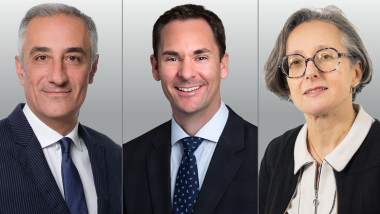Views from the Collective: What follows the bank failures?
That certainly rings true of the recent banking turmoil. The biggest series of bank failures since the Global Financial Crisis in 2008, it quickly drew doomsday comparisons to the stunning collapse of Lehman Brothers, which plunged the global economy into a deep recession and almost took down the entire financial system. Yet for savvy investors, recent market volatility has provided opportunities.
“We believe that the recent shock is largely idiosyncratic,” explained Jason Long, portfolio manager at Chicago-based Harris Associates. “Credit Suisse failed because of bad risk management. Silicon Valley Bank failed because of poor duration management with their fixed income book. And Signature and Silvergate both had significant cryptocurrency exposure and exposure to the crypto currency exchange, FTX. So, we think these issues are contained.”
Phillipe Berthelot, head of Credit and Money Market at Paris-based fixed income specialist Ostrum Asset Management, concurred. “This is not a Lehman-like moment,” he said. “There is no chaos in this environment. You do have volatility, but this is exactly how regulators should have reacted.”
Recognising opportunities
Despite the sensationalist takes from the media and elsewhere, the emergency measures implemented by the Federal Reserve and the rapid ‘shotgun wedding’ of Credit Suisse and UBS has slowly seen calm return to markets.
Bank equity and credit spreads have begun to normalise, Berthelot noted. Widely followed measures of volatility, like the VIX (for US equities) and MOVE indices (US treasuries), have fallen in recent weeks. And the Stoxx Bank Index, an index of European banking stocks, was still modestly up for the year at the end of March.1
“The MOVE Index was the highest ever, following the fall of Credit Suisse,” Berthelot added. “But this has calmed down now, and we’re beginning to see normality return.”2
Having come into 2023 favouring financial credit, Berthelot said little has changed. “Financials are where we were at the start of the year, and they’re still cheap,” he said. “A lot of people were very dark on the economy coming into the year, but we have avoided a recession so far.”
Harris’ Long echoed the Ostrum AM veteran’s enthusiasm for certain financials. He commented: “On the equity side, Harris has long owned financials that have generally benefitted from any crisis or flight to quality. If you look at what’s happening in the US, deposits outflows are flowing to the very best banks – they are large, diversified organisations with lots of excess capital and liquidity.”3
Equity valuations, meanwhile, remain attractive – just as they do in credit assets. “The equity valuations of financial stocks are trading a very dire situation right now, which we think will be avoided,” Long explained. “As a sector in Europe, for example, they’re trading at six times 1-year forward earnings, versus a long-term average of 10. So, there is real value. If anything, we’ve taken advantage of the recent price volatility to look for discounts.”4
Playing defence
Not everyone is quite so constructive, however. Though a worst-case scenario has been averted for now, the ripple effect throughout the global economy may just be slower to play out over a longer time horizon.
“It’s not exactly clear how pervasive this could be,” Loomis Sayles portfolio manager, Peter Palfrey, cautioned. “Deposit flight could still be an issue. And that means regional banks will be more concerned about capital and lending standards.”
However, investors might want to anticipate a credit slowdown while remaining flexible and open minded. “Any indicators on bank lending data will take months to feedthrough,” Palfrey continued. “Certain sectors, especially financials, have been hit. That does create opportunities in the long-term, but the question is when?”
The Boston-based manager also thinks commercial real estate is another potential shoe to drop later in the year, particularly if credit creation slows. That warrants a more defensive position.
“Certain parts of these markets are deemed to be broken, but it’s not clear that this has been fully recognised,” warned Palfrey. “If the banking crisis quiets down and yields climb higher, we would look to add bond duration. Our general positioning has been up in quality, liquidity, and duration as we brace for a slowdown and an eventual repricing of the curve.”
Loomis, Sayles & Co, Ostrum AM and Harris Associates are all affiliates of Natixis Investment Managers, and form part of our Expert Collective.
GLOSSARY
- Excess capital and liquidity – Capital is a measure of the resources banks have to absorb losses. Liquidity is a measure of the cash and other assets banks have available to quickly pay bills and meet short-term business and financial obligations. Excess capital and liquidity imply a bank has ample capital and liquidity to absorb losses in a timely fashion.
- Lehman Moment – A “Lehman Moment” describes a point at which one company's problems become everyone's problems. The term refers to the late 2008 bankruptcy of global investment bank Lehman Brothers, which soon became a major issue for US investment banks – and eventually the world.
- Lending standards – the standards and terms of the banks' lending to a business or person. Tightening standards mean a bank is more judicious with whom it extends lending to – which can cause an eventual credit slowdown that can weigh on the economy.
- MOVE Index – Refers to the Merrill Lynch Option Volatility Estimate, which measures the implied – or future expected - volatility of the US Treasury market.
- VIX Index – The Chicago Board Options Exchange's CBOE Volatility Index, or VIX Index, is an index that measures the implied – or future expected - volatility of the US stock market.
- Volatility – Volatility is the rate at which the price of a particular asset increases or decreases over a particular period. Higher stock price volatility often means higher risk.
- Yield – A measure of the income return earned on an investment. In the case of a share, the yield is the annual dividend payment expressed as a percentage of the market price of the share. For bonds, the yield is the annual interest as a percentage of the current market price.
2 Source: Blomberg: For instance, the Merrill Lynch Option Volatility Estimate, or Move Index, reached a record 198.71 on 15 March 2023
3 Source: Large banks like JPM, Citi and Bank of America saw big deposit inflows even as smaller banks saw outflows. Source: FT, https://www.ft.com/content/2b580939-a4b6-48d2-8eb6-629b4cb1e06c
4 Source: Harris, Bloomberg
This material is provided for informational purposes only and should not be construed as investment advice. Views expressed in this article as of the date indicated are subject to change and there can be no assurance that developments will transpire as may be forecasted in this article.




 All back to bonds?
All back to bonds?
 Why Everyone’s Talking About… Market Bubbles
Why Everyone’s Talking About… Market Bubbles
 Equities: How worried should we be about valuations?
Equities: How worried should we be about valuations?
 Global Corporate Bonds – Attractive Yields but Thin Risk Premium
Global Corporate Bonds – Attractive Yields but Thin Risk Premium